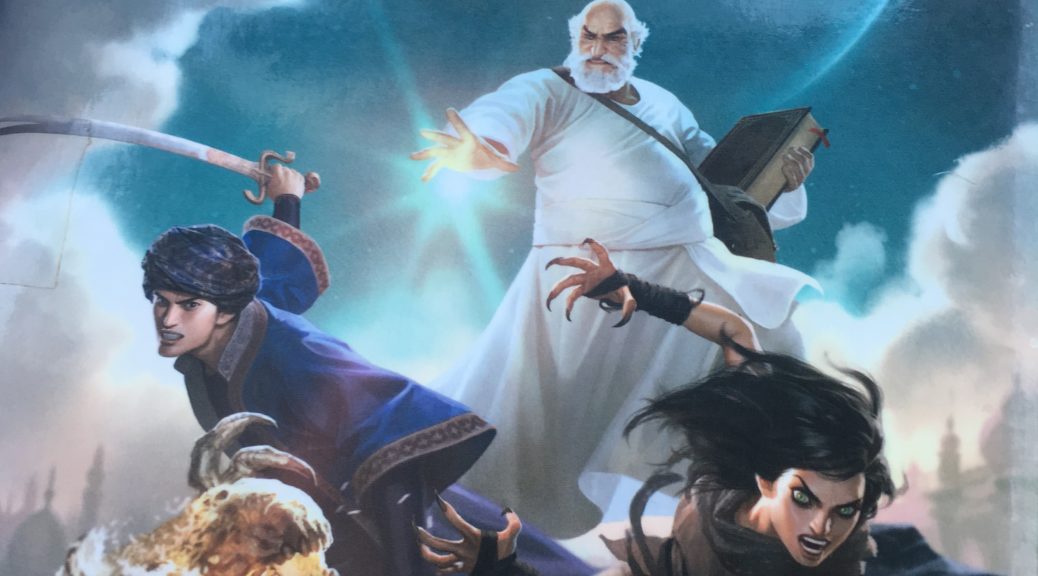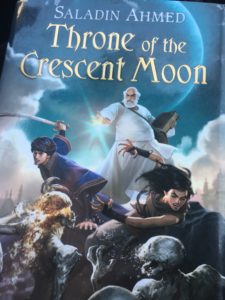
What Saladin Ahmed Gets About Evil
In February of 2017, I posted Imagination for Resistance: An Incomplete Pseudo-Syllabus. In it, I set a lofty goal of reading and sharing theological works and genre fiction created by voices in the margins. My intent was to devote 2017 to that project, and I failed miserably. You may have noticed that the post still refers to the blog as Noggin Squall, certain hyperlinks no longer work, and I even mislabeled the genre of a book on my reading list. I also included Gene Wolfe on my list under the pretense that he is an excellent writer. In hindsight, his inclusion undermines the very premise of the project. There are many places to share my love of Wolfe, but a series on genre writers that are not white men is not one of them. Bad form, Dan, bad form.
But with seminary finally over and a new career on the horizon, I dove into the book at the top of the list! If you’re a fantasy buff, I highly recommend Throne of the Crescent Moon by Saladin Ahmed.

Readers of Marvel Comics will recognize his name. Ahmed made his mark in the comic book world with his recent run on Black Bolt, and he is currently writing Exiles as part of the Marvel relaunch, Marvel Legacy. (I just recently added Exiles to my pull list and tracked down its back issues). Ahmed is also a poignant and humorous voice to follow on Twitter.
The modern fantasy genre is nearly defined by its Western, Medieval European aesthetic. This should be no surprise given that the granddaddy of modern fantasy, J.R.R. Tolkien, was a fanboy Celtic and Nordic mythology. Even today, Martin’s A Song of Fire and Ice, while exploring medieval politics on a larger, geopolitical scope, is predominantly concerned with the land of Westeros with its knights, peasants, and competing pale-skinned kings.
The opening pages of Throne of the Crescent Moon establish that this is not that sort of world. Instead, the reader is introduced to Doctor Adoulla Makhslood who is drinking spiced tea in city of Dhamsawaat. It is a bustling metropolis full of economic disparity, systemic oppression, and a brewing revolution just beneath the surface. Adoulla is an aged ghul hunter, looking to retire from the swashbuckling life of fighting the servants of the “Traitorous Angel.” Yet events occur that take him, and his sidekick Raseed bas Raseed, into a conflict of cataclysmic proportions.
It is a fantasy novel as informed by Ahmed’s heritage and Muslim faith as Tolkien’s is informed by his Roman Catholicism and decidedly English heritage. In a 2012 interview with ThinkProgess, Ahmed spoke at length about his writing process, the book’s reception from both secular and religious readers, and his thoughts on the legacy and trajectory of fantasy. Ahmed described Throne of the Crescent Moon as a “very Arab-American novel in the mix of mythology that’s in there.”
I’m hesitant to dive too deep into speculating or assuming the ways in which Islam influenced Ahmed’s story and world building, lest I presume too much or risk appropriating his theology for my own purposes. I am student of Protestant Christian theology, and my knowledge of the Koran and the diversity of Islamic thought is admittedly lacking.
Yet, there is one element in his work that I recognize from our faiths’ shared Abrahamic heritage: Evil cannot create, it can only corrupt that which is already created.
The forces of Evil that plague Dhamsawaat and the surrounding region are largely mysterious. The characters
refer to those who serve the “Traitorous Angel,” but the Traitorous Angel remains in the background, a malevolent being often referenced but never seen. Unlike Tolkien’s Sauron, whose location is known and whose forces are creatures who seek destruction from their birth, the Traitorous Angel is an obscure, near mythological character who is only recognized through the work of its servants. Whatever this cosmic opposition is, it is beyond the scope of Adoulla’s mission. The ghuls and those who create them are the Doctor’s concern.
The ghuls are creatures created from human corpses, sand, and insects. They look human, but are without free will and act the behest of their human conjuror’s magic (a necromancy of sorts). For the majority of the book, the reader never encounters the humans responsible for these monsters. However, Doctor Adoulla reminds the reader often that they are human bodies murdered, exhumed, and desecrated for the purpose of evil. The presence of evil is most evident when it perverts and twists the humanity of another person. This is only further exemplified as Ahmed describes the economic disparity and oppression that is pervasive throughout Dhamsawaat. Evil is not on equal footing with the Divine Good, but it is a corruption of that which already has been created.
the reader never encounters the humans responsible for these monsters. However, Doctor Adoulla reminds the reader often that they are human bodies murdered, exhumed, and desecrated for the purpose of evil. The presence of evil is most evident when it perverts and twists the humanity of another person. This is only further exemplified as Ahmed describes the economic disparity and oppression that is pervasive throughout Dhamsawaat. Evil is not on equal footing with the Divine Good, but it is a corruption of that which already has been created.
The fantasy genre, and particularly those works written by western Christians, often portray the conflict of Good and Evil in a Manichean dynamic in which forces of light and forces of darkness are in a dualistic conflict. They are portrayed as equals in power and ability. In the West, the resolution is often that Light eradicates the Darkness. This dynamic is present in Tolkien’s The Lord of the Rings to some extent, although his experience in World War I may be reflected in the impending shadow of Mordor. But Tolkien’s Orcs and armies of Sauron exist solely for evil means. (It should be noted that there is more nuance to the nature of Evil in Middle-earth, but that is predominantly found in The Silmarillion).
The ghuls in Throne of the Crescent Moon and the mysterious humans who create them reflect a fundamental truth of reality that fantasy stories often lack. Evil is made known through its corruption of human beings and of Creation. In the narrative of the Hebrew Scripture, and specifically from Genesis 4 through Samuel and Kings, there is no Satan mentioned. No abstract evil is personified and made manifest so that warriors of righteousness can slay it. Instead, the murder of Abel at the hands of Cain marks the beginning of the biblical text’s assertion concerning the nature of evil in our reality. Regardless of whatever Satan or demonic forces that may lurk behind the veil of the material world, we know evil most clearly in the hurt and dehumanization inflicted on our fellow human persons.
Let me say it one more time: Evil is most evident when people are treated as less than human.
And that, friends, is what Saladin Ahmed gets about evil. And I look forward to reading more of it in his worlds of fantasy to come.